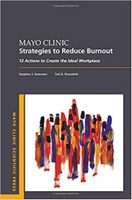Caring for the Caregiver

Burnout: It's Not You, It's the System
Have you felt that you were fighting a battle just to get through the day? You may have been fighting administrative hassles, an uncaring boss focused solely on clinical productivity, the inherent bureaucracy in an academic setting, the electronic medical record, frequent interruptions, ungrateful patients, the lack of staffing support, the burden of teaching students and residents while caring for patients, grant deadlines, trouble at home, and on and on. These factors have a cumulative impact on us and can result in emotional exhaustion, depersonalization and the feeling of a lack of efficacy in our work. We can feel like a failure when this happens. This is burnout.
Burnout is now classified as a disease by the World Health Organization's International Classification of Diseases (11th Edition, 2019). This is said to result from chronic workplace stress that "has not been successfully managed". Let's focus on where the "fix" should be targeted since the concept of burnout resonates poorly with physicians and other professional healthcare workers because it denotes an implication of a lack of resilience, a failure on their part despite years of disciplined work and practice.

A new book, Mayo Clinic: Strategies to Reduce Burnout, (Swensen and Shanafelt, T., 2020), summarizes the Mayo Clinic's approach to burnout prevention. Here is a quote from the book:
"It should be emphasized that burnout is mainly caused by systems, leaders, and characteristics of the work environment, not by a deficiency in personal well-being or resilience. When leaders begin the quest to address burnout in their organizations, they often make the mistake of starting individual-focused programs that imply the cause of burnout is due to a lack of resilience on the part of the health care professional. Staff are encouraged to "take better care of themselves" and are given the option of participating in programs that include some of the validated means to bolster resilience. With this, many leaders believe their work is done. However, this approach leaves staff with an unintended message: They are at fault for their burnout because they have not taken care of themselves" (Swensen & Shanafelt, 2020, p. 281).
Burnout vs Moral Injury
So, what is moral injury? When we are unable to put the needs of patients first...because we have obligations to other, competing entities (the electronic medical record, our productivity targets, the hospital, the insurance company, etc.), we experience a "twinge of moral injustice because this transgresses our deeply-held moral beliefs" about excellent patient care. The cumulative effect of these repeated injustices results in what these authors call moral injury.
A recent article, Re-framing Clinician Distress: Moral Injury not Burnout (Dean, Talbot & Dean, 2019), raised the question: Is burnout merely the symptom and moral injury the cause of this epidemic of healthcare provider emotional exhaustion and depersonalization? Blaming the healthcare professional"suggests a failure of resourcefulness and resilience, traits that we have finely honed during decades of intense training and demanding work. But are there systemic issues in our current healthcare environment and academic institutions that are the cause of this epidemic?"
Co-Creating the Ideal Work Environment
The Mayo Clinic focuses on making it a great place to work by changing systems and the work environment, so it supports faculty and staff to bring meaning back into work by creating a patient-focused esprit de corps. Esprit de corps is defined as "the common spirit existing in the members of a group and inspiring enthusiasm, devotion, and strong regard for the honor of the group" (Mirriam-Webster definition). Developing esprit de corps is a shared responsibility between individuals on the front lines of healthcare and leaders from across the organization. It is the driver for delivering the highest quality care in a patient-centered fashion. This shared responsibility for creating the ideal work environment touches eight elements that bring meaning and purpose to work. They are:
- Community and camaraderie at work
- Control and flexibility
- Fairness and equity
- Intrinsic motivation and rewards
- Professional development and mentorship
- Partnership
- Safety
- Trust and respect
If we are to make UofL a great place to work, a place with esprit de corps, then we need to engage front-line healthcare professionals and our leaders to embrace the system-level fixes that need to be considered and implemented to co-create the ideal work environment for us and our patients. We need a system of patient-centered clinical care in which caring for the caregiver is a top priority. The Mayo approach provides a roadmap for us.
Amazon link for Mayo Clinic: Strategies to Reduce Burnout
References
Swensen, S. J., & Shanafelt, T. D. (2020). Mayo Clinic strategies to reduce burnout: 12 actions to create the ideal workplace. New York, NY: Oxford University Press.
Dean, W., Talbot, S., & Dean, A. (2019). Reframing Clinician Distress: Moral Injury Not Burnout. Federal practitioner for the health care professionals of the VA, DoD, and PHS, 36(11), 502-504.